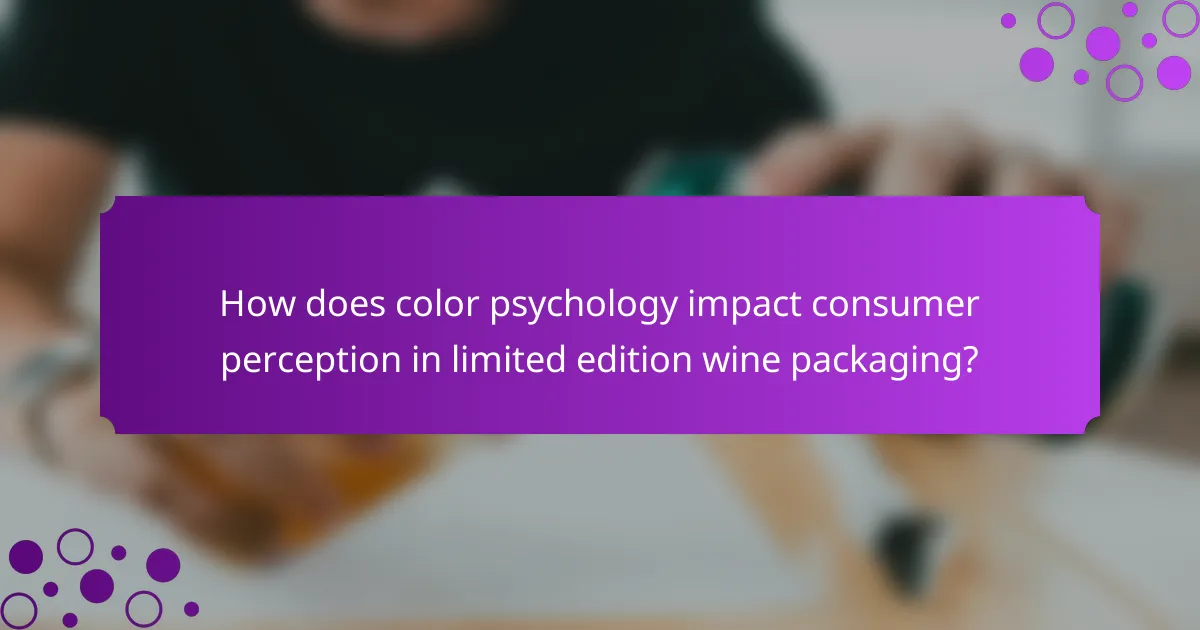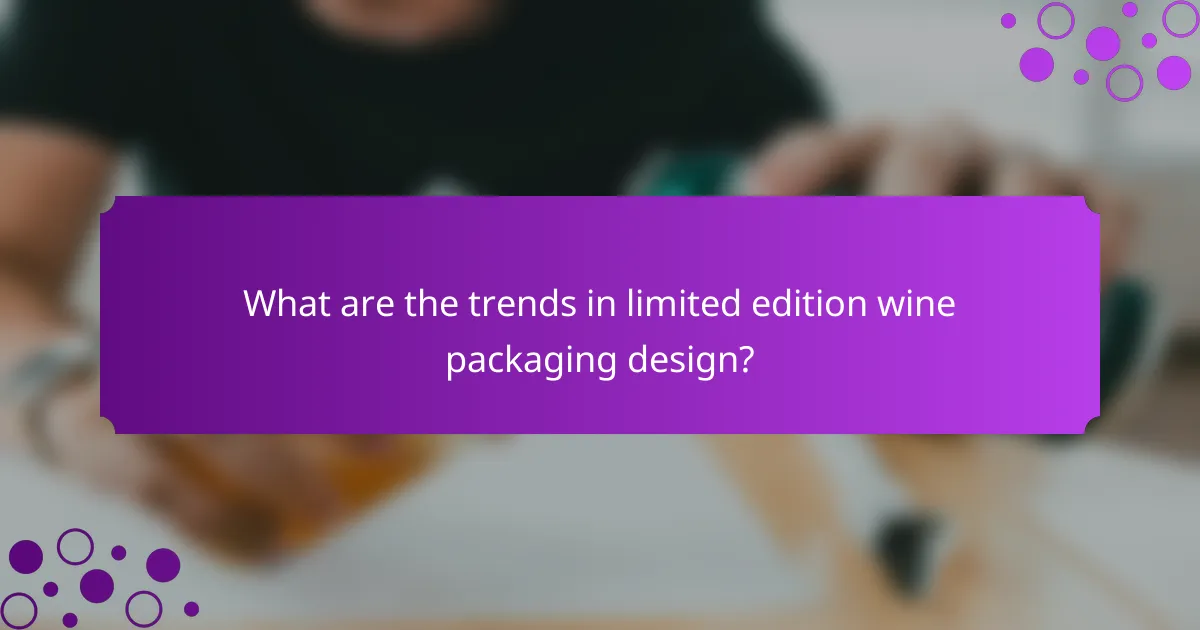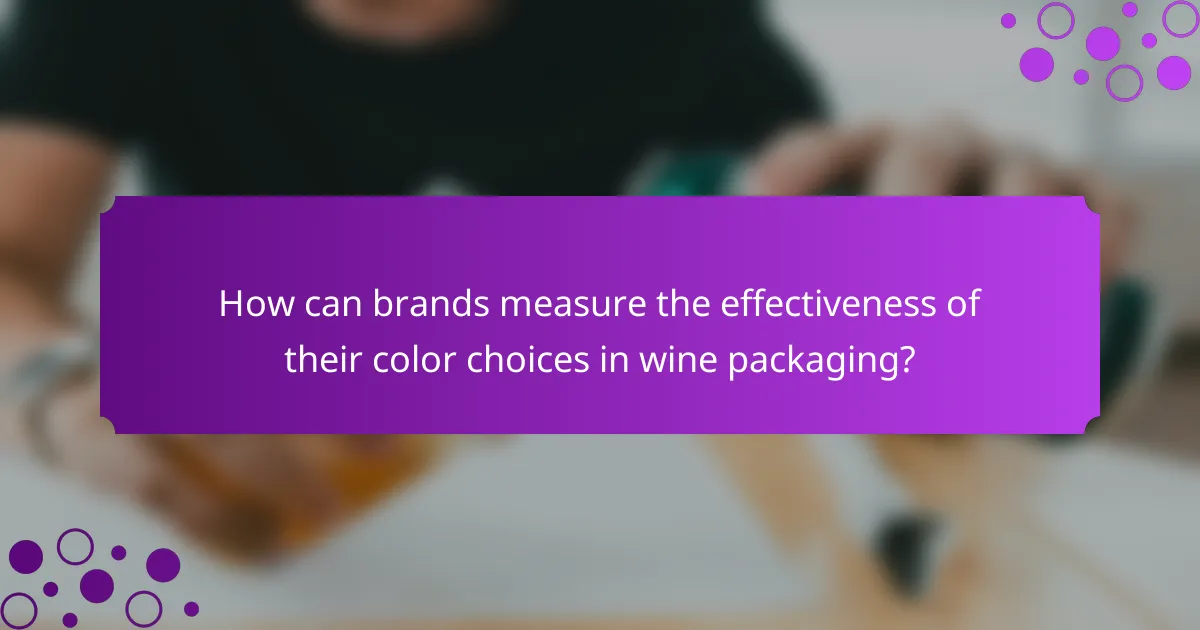
How does color psychology impact consumer perception in limited edition wine packaging?
Color psychology significantly impacts consumer perception in limited edition wine packaging. Colors evoke specific emotions and associations that influence buying decisions. For example, red often signifies luxury and passion, appealing to consumers seeking premium products. Conversely, green can represent freshness and organic qualities, attracting health-conscious buyers. Research by the Institute for Color Research found that people make a judgment about products within 90 seconds, and 62-90% of that judgment is based on color alone. This indicates that effective color choices can enhance perceived value and desirability in limited edition wines. Additionally, unique color combinations can differentiate products on shelves, making them stand out to potential buyers.
What are the key principles of color psychology?
Color psychology is the study of how colors affect human behavior and emotions. Different colors evoke specific feelings and associations. For instance, red often signifies passion and excitement. Blue is commonly associated with calmness and trust. Yellow can evoke happiness and energy. Green typically represents nature and tranquility. Understanding these associations helps brands influence consumer perceptions. Research indicates that 85% of consumers make purchasing decisions based on color. This highlights the importance of color in marketing and packaging, particularly in limited edition products like wine.
How do colors evoke emotions and influence decisions?
Colors evoke emotions and influence decisions through psychological associations. Different colors are linked to specific feelings and responses. For example, red often signifies excitement and passion. Blue is associated with calmness and trust. Research indicates that color can impact consumer behavior significantly. A study by the University of Winnipeg found that 90% of snap judgments about products are based on color alone. This shows the importance of color in marketing and branding. Effective use of color can enhance brand recognition by up to 80%. Thus, colors play a crucial role in shaping perceptions and guiding choices.
What psychological effects do specific colors have on consumers?
Specific colors have distinct psychological effects on consumers. Red often evokes excitement and passion, which can stimulate appetite and increase heart rates. Blue is associated with trust and calmness, making it effective for brands seeking to establish reliability. Yellow captures attention and is linked to optimism, but excessive use can cause anxiety. Green symbolizes health and tranquility, often appealing to environmentally conscious consumers. Black conveys sophistication and luxury, making it popular in high-end products. Research indicates that 85% of consumers base their purchase decisions on color. This highlights the significant impact of color psychology in marketing and packaging strategies.
Why is limited edition packaging important for wine brands?
Limited edition packaging is important for wine brands because it creates exclusivity and enhances perceived value. This type of packaging attracts collectors and enthusiasts who seek unique products. Limited editions often feature distinctive designs that stand out on shelves. They can also convey a brand’s identity and story effectively. Research shows that consumers are willing to pay more for products perceived as exclusive. For example, a study by the Journal of Consumer Research found that scarcity increases desirability. Additionally, limited edition releases can generate buzz and social media engagement. This can lead to increased sales and brand loyalty.
How does packaging differentiate a product in a competitive market?
Packaging differentiates a product in a competitive market by creating a unique visual identity. It captures consumer attention through design elements like color, shape, and typography. For instance, distinctive packaging can evoke emotions and influence purchasing decisions. Research indicates that 70% of purchasing decisions are made at the point of sale. Effective packaging communicates brand values and product benefits clearly. In the wine industry, limited edition packaging often utilizes color psychology to enhance perceived quality. This strategic use of color can lead to increased sales and brand loyalty.
What role does exclusivity play in consumer choice?
Exclusivity significantly influences consumer choice by creating a perception of rarity and desirability. When products are marketed as exclusive, they often attract consumers seeking unique experiences. This desire for exclusivity can lead to increased demand and higher willingness to pay. Research indicates that consumers associate exclusivity with higher quality and status. For instance, a study by Gierl and Huettl (2010) found that limited availability enhances consumer interest and perceived value. Thus, exclusivity plays a crucial role in shaping purchasing decisions and brand loyalty among consumers.
How can wine brands effectively utilize color psychology in their packaging?
Wine brands can effectively utilize color psychology in their packaging by selecting colors that evoke specific emotions and perceptions. For instance, red often signifies richness and boldness, making it suitable for full-bodied wines. White can represent purity and freshness, appealing to those seeking a crisp taste.
Additionally, using gold in packaging can convey luxury and premium quality, attracting high-end consumers. Studies show that colors can influence purchasing decisions, with 85% of consumers making choices based on color alone.
By aligning color choices with the wine’s attributes and target audience, brands can enhance their market appeal. For example, a vibrant label may attract younger consumers, while muted tones may appeal to traditionalists. This strategic use of color can lead to increased brand recognition and customer loyalty.
What colors are most commonly used in limited edition wine packaging?
Limited edition wine packaging commonly uses colors such as black, gold, red, and white. Black conveys elegance and sophistication, often appealing to premium consumers. Gold is associated with luxury and exclusivity, enhancing perceived value. Red is frequently used to signify richness and bold flavors, aligning with wine characteristics. White can symbolize purity and simplicity, often used in modern designs. These colors are strategically chosen to evoke specific emotions and attract consumer attention. Studies in color psychology support these associations, indicating that color influences purchasing decisions.
How do cultural perceptions of color affect packaging choices?
Cultural perceptions of color significantly influence packaging choices. Different cultures associate specific colors with distinct meanings and emotions. For example, in Western cultures, white symbolizes purity and simplicity, making it popular for wine packaging. In contrast, in many Asian cultures, white is associated with mourning. This can lead to avoidance of white packaging in those markets.
Additionally, red is often linked to celebration and good fortune in China, making it a favored choice for wine packaging aimed at that demographic. Studies show that colors can impact consumer behavior, with 85% of consumers making purchasing decisions based on color alone.
Therefore, brands must consider cultural color perceptions to appeal to their target audiences effectively. This strategic choice in color can enhance brand image and increase sales.

What are the trends in limited edition wine packaging design?
Current trends in limited edition wine packaging design focus on sustainability and unique aesthetics. Many brands are opting for eco-friendly materials to appeal to environmentally conscious consumers. This includes using recycled glass and biodegradable labels. Bold colors and artistic designs are also becoming popular. These designs often incorporate local art or cultural elements to create a connection with the consumer. Minimalist designs are trending as well, emphasizing simplicity and elegance. Custom shapes and innovative closures are being used to enhance the unboxing experience. Additionally, storytelling through packaging is gaining traction, allowing brands to convey their heritage or winemaking process. These trends reflect an evolving market that values both aesthetics and sustainability.
How are brands innovating with color in their packaging?
Brands are innovating with color in their packaging by utilizing bold and unexpected color combinations. This approach captures consumer attention and enhances product visibility. For instance, many wine brands are experimenting with vibrant hues to differentiate limited edition offerings. Research indicates that colors can evoke specific emotions and perceptions about a product. A study by the Institute for Color Research found that people make a subconscious judgment about a product within 90 seconds, with color accounting for 85% of that decision. Brands are also using color to convey messages about sustainability and quality. For example, earthy tones often signal organic or natural products. These innovations in color not only attract consumers but also align with their values and preferences.
What techniques are used to create eye-catching color combinations?
Techniques to create eye-catching color combinations include using complementary colors, analogous colors, and triadic color schemes. Complementary colors are opposite each other on the color wheel, enhancing contrast. For example, blue and orange create a striking visual effect. Analogous colors are next to each other on the wheel, providing harmony. This technique creates a cohesive and pleasing palette. Triadic color schemes use three evenly spaced colors on the wheel, offering balance and vibrancy. For instance, red, yellow, and blue together create a dynamic look. Additionally, using color psychology principles can evoke specific emotions, influencing consumer perception. Research shows that colors can affect purchasing decisions, making these techniques valuable in marketing contexts like wine packaging.
How do seasonal trends influence color choices in wine packaging?
Seasonal trends significantly influence color choices in wine packaging. During spring and summer, wineries often choose vibrant colors like greens and yellows to evoke freshness and warmth. In contrast, autumn and winter tend to see deeper colors such as reds and golds, reflecting the harvest and festive seasons.
These color selections align with consumer expectations and emotional responses tied to seasonal experiences. For example, bright colors can attract attention and suggest lightness, appealing to consumers during warmer months. Conversely, darker hues can create a sense of coziness and richness, resonating with the feelings of comfort associated with colder weather.
Research indicates that color can affect purchasing decisions; studies show that 85% of consumers base their purchase decisions on color alone. This demonstrates the importance of aligning packaging colors with seasonal trends to maximize appeal and sales.
What challenges do brands face when selecting colors for limited edition packaging?
Brands face several challenges when selecting colors for limited edition packaging. One major challenge is ensuring brand consistency. Colors must align with the overall brand identity to avoid confusing consumers. Another challenge is appealing to target demographics. Different colors evoke varying emotions and preferences among consumer groups. Additionally, brands must consider market trends. Colors that are trendy can enhance appeal but may quickly become outdated.
Another issue is cultural significance. Colors can have different meanings in different cultures, which brands must navigate carefully. Brands also face production limitations. Certain colors may be difficult to reproduce accurately in print or materials. Lastly, time constraints can pressure brands to make quick decisions without thorough research. Each of these factors can complicate the color selection process for limited edition packaging.
How can brands ensure their color choices resonate with their target audience?
Brands can ensure their color choices resonate with their target audience by understanding color psychology. Different colors evoke specific emotions and associations. For instance, red can signify passion and excitement, while blue often conveys trust and calmness. Research shows that 85% of consumers make purchasing decisions based on color. Brands should conduct market research to identify color preferences within their target demographic. Testing color palettes through focus groups can provide insights into consumer reactions. Additionally, analyzing competitors can reveal successful color strategies in the market. By aligning color choices with the brand’s identity and audience expectations, brands can enhance their product appeal.
What are the risks of misusing color in packaging design?
Misusing color in packaging design can lead to brand misrepresentation and consumer confusion. Incorrect color choices may not align with the brand’s identity or message. For example, using bright colors for a luxury wine may suggest low quality. This can alienate the target audience and diminish perceived value. Additionally, colors can evoke specific emotions and associations. If a color does not resonate with cultural meanings, it may offend or mislead consumers. Research indicates that 85% of consumers base their purchasing decisions on color. Poor color usage can result in decreased sales and brand loyalty.

How can brands measure the effectiveness of their color choices in wine packaging?
Brands can measure the effectiveness of their color choices in wine packaging through consumer feedback and sales data analysis. Surveys can gauge consumer preferences and emotional responses to different colors. Eye-tracking studies can reveal which colors attract attention on shelves. A/B testing can compare sales performance between different color designs. Additionally, social media engagement metrics can indicate consumer reactions to packaging colors. Research shows that color can influence purchasing decisions by up to 85%. Studies indicate that 93% of consumers make purchase decisions based on visual appearance. This data confirms that color choices significantly impact consumer behavior in wine packaging.
What metrics can be used to evaluate consumer response to packaging color?
Metrics to evaluate consumer response to packaging color include sales data, consumer surveys, and eye-tracking studies. Sales data reflects the direct impact of color on purchase decisions. Consumer surveys gather qualitative feedback on emotional responses to color choices. Eye-tracking studies measure visual attention and engagement with packaging colors. These metrics provide insights into consumer preferences and behaviors. Research indicates that color can influence up to 85% of purchasing decisions, highlighting its importance in packaging design.
How can brands conduct consumer surveys to gather feedback on color preferences?
Brands can conduct consumer surveys to gather feedback on color preferences by utilizing online survey tools. These tools allow for easy distribution and collection of responses. Brands should design surveys that include color palettes for consumers to evaluate. Questions can focus on emotional responses to specific colors. Additionally, brands can incorporate multiple-choice questions for selecting preferred colors. Open-ended questions can provide qualitative insights into consumer preferences. Analyzing survey results helps brands understand trends and preferences. Research indicates that 85% of consumers make purchase decisions based on color. This data underlines the importance of color in branding and packaging strategies.
What role does sales data play in assessing packaging effectiveness?
Sales data is crucial in assessing packaging effectiveness. It provides measurable insights into consumer purchasing behavior. By analyzing sales figures, businesses can determine which packaging designs lead to higher sales. This data reveals the impact of visual elements like color and design on consumer preferences. For instance, a study found that products with appealing packaging saw a 30% increase in sales. Sales data also helps identify trends over time, allowing for adjustments in packaging strategies. Additionally, it enables companies to compare different packaging options and their performance. Ultimately, sales data serves as a key indicator of how well packaging resonates with consumers.
What best practices should wine brands follow when designing limited edition packaging?
Wine brands should prioritize uniqueness and storytelling in limited edition packaging design. Unique packaging differentiates the product in a competitive market. Storytelling engages consumers emotionally, enhancing brand connection.
Using high-quality materials elevates perceived value. Research shows that premium packaging can increase consumer willingness to pay by up to 30%. Color selection should align with brand identity and evoke the desired emotions. For example, red can signify passion, while gold may represent luxury.
Incorporating tactile elements can enhance the sensory experience. Textures can create a memorable touchpoint for consumers. Limited edition designs should also consider sustainability to appeal to environmentally conscious consumers.
Finally, clear labeling of limited edition status can create urgency. This encourages prompt purchasing decisions, as consumers may fear missing out on exclusive offerings.
How can brands create a cohesive color strategy that aligns with their brand identity?
Brands can create a cohesive color strategy by defining their brand identity. This includes understanding their target audience and brand values. Consistent color usage across all platforms reinforces brand recognition. Research shows that color can increase brand recognition by up to 80%. Brands should select a color palette that reflects their personality and resonates with consumers. Testing color choices through consumer feedback can validate their effectiveness. Additionally, maintaining consistency in color application across packaging, marketing materials, and digital presence is crucial. This approach ensures that the brand’s visual identity is easily recognizable and memorable.
What are some tips for testing color options before finalizing packaging design?
Test color options by creating mock-ups of the packaging. Use high-quality prints to visualize colors accurately. Gather feedback from focus groups to understand emotional responses. Compare colors under different lighting conditions to assess consistency. Implement A/B testing with variations in color to see which performs better. Utilize digital tools for color simulations to save time and costs. Analyze competitor packaging to identify effective color strategies. Document all findings for future reference and decision-making.
The main entity of the article is color psychology in limited edition wine packaging. The article explores how color influences consumer perception, purchasing decisions, and brand identity in the wine industry. Key topics include the emotional effects of specific colors, the importance of exclusivity in packaging, and the role of cultural perceptions in color choices. Additionally, it discusses best practices for wine brands to effectively utilize color psychology in their packaging design to enhance market appeal and consumer engagement. Insights from research and consumer behavior studies underscore the significant impact of color on sales and brand loyalty.